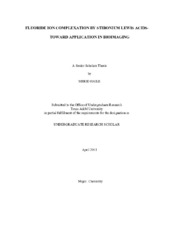| dc.contributor.advisor | Gabbai, François P | |
| dc.creator | Haile, Merid 1989- | |
| dc.date.accessioned | 2013-06-04T16:11:49Z | |
| dc.date.available | 2013-06-04T16:11:49Z | |
| dc.date.created | 2011-05 | |
| dc.date.issued | 2011-05-06 | |
| dc.date.submitted | May 2011 | |
| dc.identifier.uri | https://hdl.handle.net/1969.1/ETD-TAMU-2011-05-9681 | |
| dc.identifier.uri | https://hdl.handle.net/1969.1/148802 | |
| dc.description.abstract | Fluoride has proven to be a helpful anion in improving dental health when added to drinking water and toothpaste but extremely detrimental to the body at higher concentrations. Its isotope 18F is useful as a labeling agent in PET imaging. Due to these applications, much effort has been devoted to the development of methods allowing to
sense this anion in aqueous solution. In this thesis, I will discuss the results that I have obtained on the use of stibonium cations as anion receptors. Remarkably, these
antimony species react with fluoride ions in organic solvents and sometimes in aqueous solutions to form the corresponding fluorostiboranes. Formation of these fluoride species can be conveniently monitored by a variety of techniques such as UV-vis and NMR spectroscopy. | en |
| dc.format.mimetype | application/pdf | |
| dc.subject | Stibonium | en |
| dc.subject | Imaging | en |
| dc.subject | Anion sensing | en |
| dc.title | FLUORIDE ION COMPLEXATION BY STIBONIUM LEWIS ACIDSTOWARD APPLICATION IN BIOIMAGING | en |
| dc.type | Thesis | en |
| thesis.degree.department | Chemistry | en |
| thesis.degree.discipline | Chemistry | en |
| thesis.degree.grantor | Honors and Undergraduate Research | en |
| thesis.degree.name | Bachelor of Science | en |
| dc.type.material | text | en |
| dc.date.updated | 2013-06-04T16:11:49Z | |


